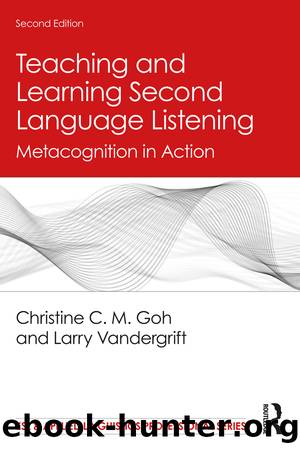Teaching and Learning Second Language Listening by Goh Christine C. M.;Vandergrift Larry;

Author:Goh, Christine C. M.;Vandergrift, Larry;
Language: eng
Format: epub
Publisher: Taylor & Francis Group
Published: 2022-09-15T00:00:00+00:00
Some of the well-known methods for facilitating comprehension address the fact that learners find the speed of listening texts too fast. One of these techniques is slowing down the speed of the text. Teachers can draw on research into this option to decide if it is useful to help students develop real-life listening skills.
It is self-evident that speech rate affects comprehension. Even the comprehension of L1 listeners begins to decline for texts with a speech rate above 300 words per minute. Griffiths (1990) found that this number drops to about 200 words per minute for intermediate-level learners of English (or 3.8 syllables per second). In other words, for texts with a speech rate of more than 200 wpm, the scores of L2 listeners on comprehension questions related to the content of the text are appreciably compromised. After determining that many texts are delivered at rates higher than 200 wpm, Griffiths (1991) investigated the comprehension of stories spoken at three different speech rates. Stories delivered at 188 wpm resulted in better comprehension scores than texts delivered at 250 wpm. Similarly, stories delivered at 127 wpm resulted in better comprehension scores than those delivered at 188 wpm. The difference in comprehension scores for the two texts with faster speech rates did not differ significantly, suggesting that a speech rate of about 127 wpm can be beneficial to facilitate comprehension for intermediate-level listeners. For comparison purposes, audio books in L1 are usually delivered at the speed of about 150â160 words per minute.
However, the results obtained by Griffiths are not corroborated by other research on speech rate (e.g., Blau, 1990; Rader, 1991). This prompted Zhao (1997) to examine speech rate from a different perspective. He gave learners the option of choosing the speed for listening to a text, using technology that could control speed without distortion to pitch. Zhao found that listeners performed better on the comprehension task when they had control over speech rate and repetition, although the chosen speech rate varied greatly by listener. While this result appears to support the results obtained by Griffiths, Zhao cautions that L2 listeners are unique individuals with different perceptions of what is fast or slow. Furthermore, he cautioned that learners who use this approach may not âpushâ themselves adequately and may opt to slow down speech rate to a level of comfort below what they might actually still be able to understand.
The studies by Griffiths and Zhao provide empirical evidence for enhancing comprehension through reduced speech rate; they do not, however, answer the question whether speed reduction can help L2 listeners develop the skills and strategies necessary for real-life listening. In other words, does practice at reduced speech rates improve the comprehension of texts spoken naturally by competent speakers of English in authentic contexts?
The effects of reduced speech rate and exact repetition of the oral text were examined by Jensen and Vinther (2003) using a pre- and post-listening measure. Three experimental groups and a control group listened to videotaped dialogues in different modes, Fast (F) and Slow (S) in different patterns.
Download
This site does not store any files on its server. We only index and link to content provided by other sites. Please contact the content providers to delete copyright contents if any and email us, we'll remove relevant links or contents immediately.
Navigation and Map Reading by K Andrew(4887)
Spare by Prince Harry The Duke of Sussex(4784)
Tuesdays with Morrie by Mitch Albom(4394)
Cracking the GRE Premium Edition with 6 Practice Tests, 2015 (Graduate School Test Preparation) by Princeton Review(4041)
Machine Learning at Scale with H2O by Gregory Keys | David Whiting(3611)
What It Really Takes to Get Into Ivy League and Other Highly Selective Colleges by Hughes Chuck(3551)
Never by Ken Follett(3520)
Goodbye Paradise(3444)
Harry Potter and the Prisoner of Azkaban (Book 3) by J. K. Rowling(3108)
Pledged by Alexandra Robbins(3045)
Kick Ass in College: Highest Rated "How to Study in College" Book | 77 Ninja Study Skills Tips and Career Strategies | Motivational for College Students: A Guerrilla Guide to College Success by Fox Gunnar(2997)
Fairy Tale by Stephen King(2942)
A Dictionary of Sociology by Unknown(2849)
Sapiens and Homo Deus by Yuval Noah Harari(2842)
The Social Psychology of Inequality by Unknown(2759)
Reminders of Him: A Novel by Colleen Hoover(2752)
Graduate Admissions Essays, Fourth Edition: Write Your Way into the Graduate School of Your Choice (Graduate Admissions Essays: Write Your Way Into the) by Asher Donald(2733)
Get into Any College by Tanabe Gen Tanabe Kelly(2628)
Zero to Make by David Lang(2623)
